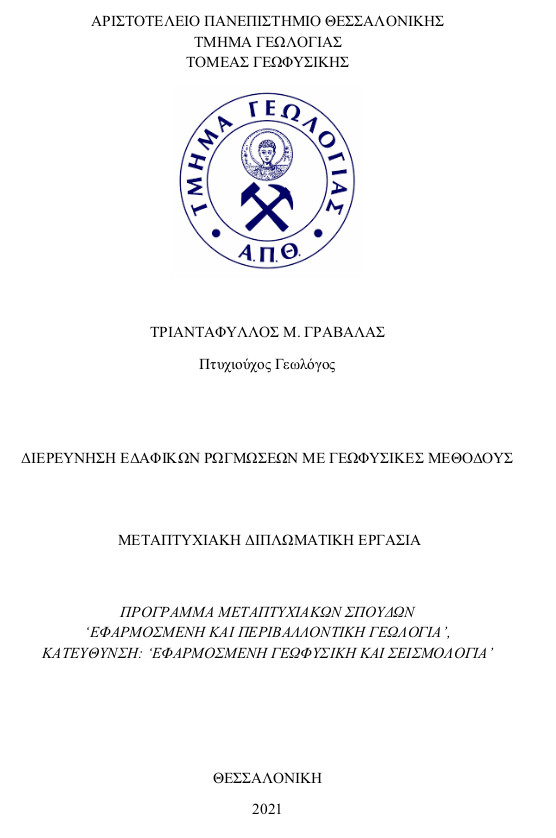
Διερεύνηση εδαφικών ρωγμώσεων με γεωφυσικές μεθόδους = Investigation of soil cracks by the use of geophysical methods.
Περίληψη
Το αντικείμενο της παρούσας εργασίας είναι η διερεύνηση εδαφικών ρωγμώσεων με γεωφυσικές μεθόδους. H περιοχή μελέτης είναι η κωμόπολη των Λαγυνών η οποία ανήκει στον δήμο Λαγκαδά της Θεσσαλονίκης. Στα Λαγυνά το έτος 2004 εμφανίστηκε μια ζώνη με επιφανειακές διαρρήξεις με τη μορφή εδαφικών ρωγμώσεων προκαλώντας βλάβες και φθορές σε αρκετά παρακείμενα οικήματα της περιοχής. Ως στόχος της παρούσας διατριβής ορίστηκε η μελέτη των αιτίων εμφάνισης το φαινομένου μέσω του καθορισμού της γεωλογικής δομής υπεδάφους, με τη βοήθεια των μεθόδων γεωφυσικής διασκόπησης. Για τις ανάγκες της έρευνας, εφαρμόστηκαν η μέθοδος της γεωηλεκτρικής τομογραφίας, η μέθοδος της σεισμικής διάθλασης, η μέθοδος της πολυκάναλης ανάλυσης επιφανειακών κυμάτων και η μέθοδος του υπεδάφιου γεωραντάρ (GPR). Αρχικά, πραγματοποιήθηκε η μέθοδος της γεωηλεκτρικής τομογραφίας και στη συνέχεια πιο στοχευμένα πραγματοποιήθηκαν οι σεισμικές μέθοδοι οι οποίες ερμηνεύτηκαν συνδυαστικά παρέχοντας και επιβεβαιώνοντας σημαντικές πληροφορίες για την στρωματογραφία και τη λιθολογία του υπεδάφους. Η μέθοδος του υπεδάφιου γεωραντάρ κρίθηκε η καταλληλότερη μέθοδος μελέτης στα σημεία όπου οι εδαφικές ρωγμώσεις διέρχονται από οδοστρώματα. Οι γεωφυσικές μετρήσεις υπέστησαν επεξεργασία με ειδικά γεωφυσικά προγράμματα και εξήχθησαν τα κατάλληλα αποτελέσματα. Όσον αφορά τα αποτελέσματα της γεωφυσικής έρευνας, αυτά έρχονται σε καλή συμφωνία με τα γεωλογικά στοιχεία καθώς και με έρευνες προηγούμενων ερευνητών για το φαινόμενο των εδαφικών ρωγμώσεων. Οι γεωφυσικές μέθοδοι παρήγαγαν μια πολύ καλή εικόνα της στρωματογραφίας της περιοχής μελέτης. Αν οι γεωφυσικές μετρήσεις συσχετιστούν με τα γεωλογικά δεδομένα που είναι ήδη γνωστά για την περιοχή, πιθανολογείται ότι η εμφάνιση των εδαφικών ρωγμώσεων ίσως οφείλεται σε φαινόμενα διαφορικής συνίζησης του υδροφόρου λόγω υπεράντλησης του, ενώ η ύπαρξη του ρήγματος στην περιοχή ευνόησε τις συνθήκες ανάπτυξης του φαινομένου.
The subject of this thesis is the investigation of soil cracks by the use of geophysical methods. The area of interest is the town of Lagyna of the Langadas municipality in Thessaloniki. At Lagyna, in the year 2004, a disruption zone appeared in the shape of surface soil cracks causing failures and damages at many buildings of the area. The purpose of this thesis is to study the exact causes of the development of the phenomenon by interpretating the geological structure of the subsurface with the use of applied geophysical methods. We have applied electrical resistivity tomography method (ERT), seismic refraction method, multichannel analysis of surface waves method (MASW) and ground penetrating radar method (GPR). Firstly, we applied the ERT method and then the seismic methods that have been interpreted in correlation to provide and confirm important information about the subsoil stratigraphy and lithology. The GPR method was considered the most appropriate study method at the point where soil cracks passed through asphalt. The geophysical data were processed with the use of geophysical software to obtain the best fitting results. The results of the geophysical survey come in good agreement with the geological setting of the area and with the surveys of further researchers for the cause of the development of soil cracks. The geophysical methods provided a very good view of the stratigraphy of the area of interest. If we correlate the geophysical measurements with the geological data that are already known for the area of interest, it is probable that the development of the soil cracks may have occurred by subsidence from the overpumping of groundwater, while the existence of a normal fault at the area may be conducive for the conditions of the phenomenon development.
The subject of this thesis is the investigation of soil cracks by the use of geophysical methods. The area of interest is the town of Lagyna of the Langadas municipality in Thessaloniki. At Lagyna, in the year 2004, a disruption zone appeared in the shape of surface soil cracks causing failures and damages at many buildings of the area. The purpose of this thesis is to study the exact causes of the development of the phenomenon by interpretating the geological structure of the subsurface with the use of applied geophysical methods. We have applied electrical resistivity tomography method (ERT), seismic refraction method, multichannel analysis of surface waves method (MASW) and ground penetrating radar method (GPR). Firstly, we applied the ERT method and then the seismic methods that have been interpreted in correlation to provide and confirm important information about the subsoil stratigraphy and lithology. The GPR method was considered the most appropriate study method at the point where soil cracks passed through asphalt. The geophysical data were processed with the use of geophysical software to obtain the best fitting results. The results of the geophysical survey come in good agreement with the geological setting of the area and with the surveys of further researchers for the cause of the development of soil cracks. The geophysical methods provided a very good view of the stratigraphy of the area of interest. If we correlate the geophysical measurements with the geological data that are already known for the area of interest, it is probable that the development of the soil cracks may have occurred by subsidence from the overpumping of groundwater, while the existence of a normal fault at the area may be conducive for the conditions of the phenomenon development.
Πλήρες Κείμενο:
PDFΕισερχόμενη Αναφορά
- Δεν υπάρχουν προς το παρόν εισερχόμενες αναφορές.
